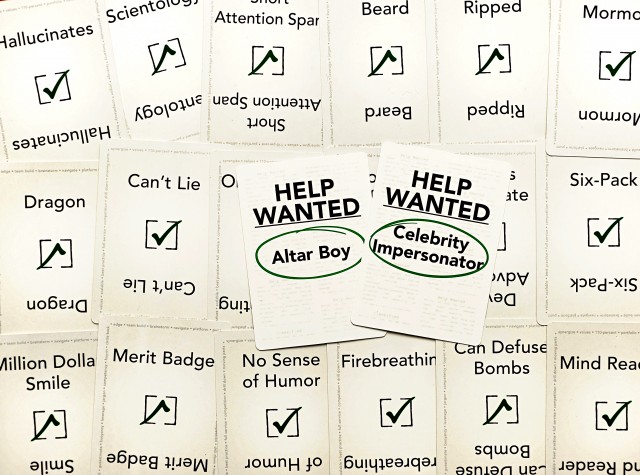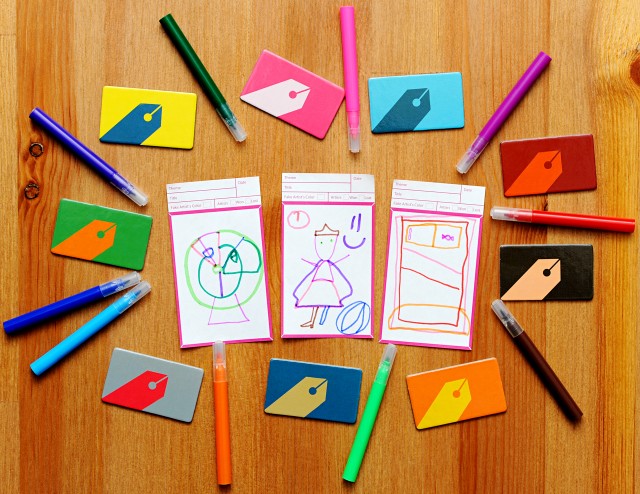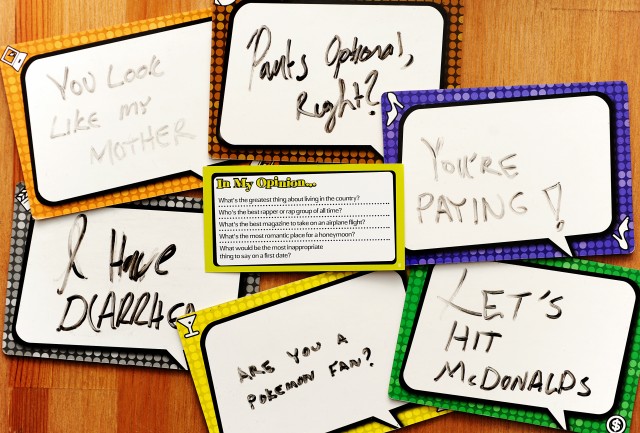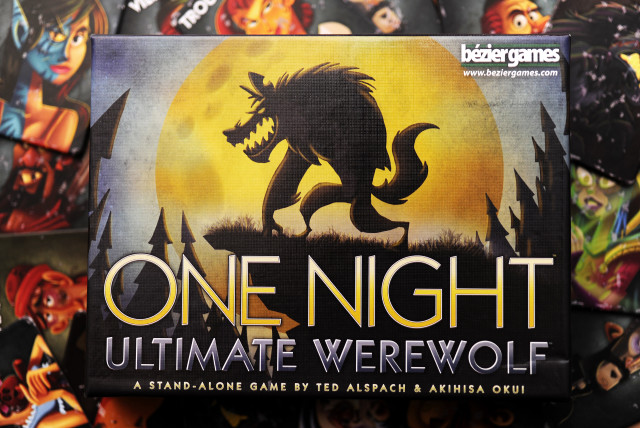It’s happened to us all, at a work gathering, casual party or even at a regular game night. You need something light and quick to play and someone brings out that black, rectangular box. We’ve likely all played Cards Against Humanity (CAH) at a social/gaming gathering. And, if you’re like me, you’ve had to play it just one too many times now. I’m here with some suggestions for games that might not directly replace CAH, but are a great step to the side as far as fun/party-ish games that are ideal for casual gatherings or to cap off your night of board gaming. With some of these you can have as much dirty humour or as little as you like, and the rest offer a great way to interact with your friends without relying too much on creating humour but just straight up having fun. I can almost guarantee your friends and/or gaming group will thank you for introducing them to these games.
Funemployed: You’re looking for a job, and you’ll apply for pretty much anything. The judge for each round draws a position to apply for, and with the traits you end up with in your hand, you go in for an ‘interview’ (i.e pitch what about those traits makes you perfect for the job) and hopefully land it!
 One of the more frustrating aspects of games like CAH and Apples to Apples is getting stuck with cards you don’t feel like you can do much with to try and win a round. Funemployed adds some flexibility to the “cards as fun answers” format by not just dealing you a hand of cards, but also having a shared selection of cards on the table that active players can all swap out with cards in their hands. Plus, that all happens frantically at the same time, so when one player figures they’ve got their best answer, everyone then has to stop and the ‘job interviews’ start. Listening to everyone’s pitches is a real laugh riot, and it’s awesome seeing how creatively some people can spin their traits to sound perfect for the job!
One of the more frustrating aspects of games like CAH and Apples to Apples is getting stuck with cards you don’t feel like you can do much with to try and win a round. Funemployed adds some flexibility to the “cards as fun answers” format by not just dealing you a hand of cards, but also having a shared selection of cards on the table that active players can all swap out with cards in their hands. Plus, that all happens frantically at the same time, so when one player figures they’ve got their best answer, everyone then has to stop and the ‘job interviews’ start. Listening to everyone’s pitches is a real laugh riot, and it’s awesome seeing how creatively some people can spin their traits to sound perfect for the job!
Funemployed is published by Urban Island Games. It can play from 3 – 20 people, ages 13 and up, and takes approximately 30 minutes.
But Wait, There’s More!: I don’t know about you, but I am often rambling little infomercials off the top of my head for weird stuff. It slices, it dices.. Actually, no it doesn’t do any of that, it’s just a dirty sock on the

floor. With But Wait, There’s More! you as a group will be pitching the same product to the market, but each with a different twist. You’re representing your company pitching, say, a broom. Your broom could be self-propelled and you want to talk that up in your pitch to the table. But wait, there’s more! Oh yes, here is the chaotic fun – flip over a random trait and incorporate that into your pitch. Ah, my broom is self-propelled and also removes unwanted hair quickly and painlessly!
What I like most about But Wait, There’s More! beyond the hilarious fun you can have coming up with your pitches, is that everyone gets to play each round – there’s no ‘judge’ sitting there missing the creativity for that round. Everyone takes part, and once all the pitches are done, then each player hands out point cards to ‘vote’ who they thought had the better pitches. (And even better, you don’t tally points until the end of the game so there’s no pressure for those not doing as well which makes things far more fun!)
But Wait, There’s More! is published by Toy Vault Inc. It can play from 3 – 10 players, ages 14 and up, and takes approximately 30 minutes.
A Fake Artist Goes to New York: Many of our readers will have tried Pictionary at some point in their lives. A Fake Artist Goes to New York takes elements of Pictionary and takes a wild side step into a group guessing game with some ridiculously fun results.  Each round, a question master will write a keyword (a person, place or thing, generally) on small cards to hand out to the other players – however, one of these will be blank, meaning that this player has secretly been designated the “Fake Artist”. The starting player will mark one line to start the collective drawing – they’re hoping to indicate to their fellow ‘real’ artists that they know what they’re drawing without giving it away. The “Fake Artist” will also take part in marking a line in the drawing, hoping they can bluff their way to looking like they know what’s going on.
Each round, a question master will write a keyword (a person, place or thing, generally) on small cards to hand out to the other players – however, one of these will be blank, meaning that this player has secretly been designated the “Fake Artist”. The starting player will mark one line to start the collective drawing – they’re hoping to indicate to their fellow ‘real’ artists that they know what they’re drawing without giving it away. The “Fake Artist” will also take part in marking a line in the drawing, hoping they can bluff their way to looking like they know what’s going on.
Let’s get real: nothing you’ll draw in this game looks remotely like a thing should in real life, and that’s part of the fun. “But I was drawing a princess!” “What the hell is that, then?!” Once the canvas has gone around the players twice, the artists will look at the finished product and try to figure out who the “Fake Artist” is. On the count of three, fingers are pointed – if the “Fake Artist” was caught out, they have a last chance to win the round by guessing what the other players were trying to draw. If the “Fake Artist” wasn’t caught, then they and the question master have gotten away with their deceit! This is a great, quick game that’s easy for people to take part in, and I guarantee folks will have a lot of fun with the interaction that the drawing round offers.
A Fake Artist Goes to New York is published by Oink Games. It can play from 5 – 10 players, ages 8 and up, and takes approximately 20 minutes.
Say Anything: The great thing about Say Anything is that you can sit down and play it straight up as a clever and fun little family game, or you can get as raunchy as you like playing this over some adult beverages with friends. The judge each round will pick a question from those provided – “In my opinion, who is the best boy band in the world?” or  “In my opinion, what’s the best pizza topping” – and ask the group. Each player has a small whiteboard on which they’ll write their answer, straight or wacky, and submits it. The judge will secretly pick their favourite of the lot, and players then use two voting chips to throw their points behind the answer they think the judge has picked. And that’s a round – simple as that!
“In my opinion, what’s the best pizza topping” – and ask the group. Each player has a small whiteboard on which they’ll write their answer, straight or wacky, and submits it. The judge will secretly pick their favourite of the lot, and players then use two voting chips to throw their points behind the answer they think the judge has picked. And that’s a round – simple as that!
Say Anything is usually my first suggestion to someone who’s looking for something to play once they’ve tired of CAH. The provided questions offer some boundaries and save the judge from having to come up with something, but the open-ended answering system allows for creativity and fun, for friends who know each other well to really personalize answers or refer to in-jokes.
Say Anything is published by North Star Games. It can play from 3 – 8 players, ages 13 and up, and takes approximately 30 minutes.
Anomia: Fun, frantic and oh so shouty, Anomia is one of my favourite and most simple party games to bring to the table for a group. Players take turns flipping cards onto the pile in front of them – if their card’s symbol matches another player’s, they have to try and name an example of the category on the other player’s card before being beaten to it by

them. For example, I flip a card with 4 red dots which matches another player’s – I try to name a fairy tale character before they name an astronaut (the category on my card). Whoever gets in first gets the other player’s card as a point, and the game continues until the deck runs out.
While much of the game is keeping an eye out on cards, I always enjoy hearing the ideas that people come up with and shout, trying to win a point. When it’s tough to tell who won, there’s a tie-breaker where a card is flipped and whoever names something from that card’s category wins. Be fast, and you’ll be the Anomia master. To add another layer of flavour and complexity, wild cards make two different symbols equal, throwing more confusion and quicker thinking into the mix. This is definitely a great warm-up for game night, or for between other, meatier games.
Anomia is published by Anomia Press. It can play from 3 – 6 players ages 10 and up, and takes approximately 20 minutes.
“One Night” monster games: Bezier Games have a great series of social deduction games that play fantastically as their own standalone experiences, or can be combined for epic play. One Night Ultimate Werewolf, One Night Ultimate Werewolf: Daybreak and One Night Ultimate Vampire play out in 10-15 minutes on average and offer enormous amounts of variability and replayability, so while it could be a great end-of night game to  wrap up quickly, it is also something I have played for a couple of hours at a time. You get drawn into the gameplay of the One Night games very easily – the deception, the debate and the downfall come the voting round are filled with not just tension but also a laugh more often than not.
wrap up quickly, it is also something I have played for a couple of hours at a time. You get drawn into the gameplay of the One Night games very easily – the deception, the debate and the downfall come the voting round are filled with not just tension but also a laugh more often than not.
Every player is secretly assigned a role – some of which have special actions. During the short ‘night phase’ players close their eyes, and the app will guide everyone through when to take their special actions (if any). Once the night phase is over, players open their eyes and all bets are off – players can be a little truthful, a lot or… not at all. Accusations of who might be the werewolves (and others) go around the table, as some players need to weed out the bad from the good to win – but the bad guys will be trying their hardest to keep the wool pulled over everyone’s eyes. Social deduction games are a favourite of mine for groups, and I especially enjoy the One Night series as the game’s setup makes it easy to learn and play, and make folks want to come back for more.
One Night Ultimate Werewolf, One Night Ultimate Werewolf: Daybreak and One Night Ultimate Vampire are published by Bezier Games. They can play from 3 – 10 players (or up to 7 when using just Daybreak) ages 10 and up, and take approximately 10 minutes.
Honorable Mentions: We wanted to keep this list of suggestions under control, and it was hard! There’s a lot of great group games out there, so here’s our honourable mentions – check them out! Codenames, Moods, Portrayal/Identik, The Game of Things… (aka Things), Time’s Up, Spyfall, and Bezier Games’ collaboration with Indie Board and Cards – One Night Revolution.
There is also The Metagame, which might possible be a partial inspiration for CAH. Played almost exactly like CAH except it is pop culture/arts/history based and instead of the black cards, everyone plays a colored “opinion” card and then players empty out their entire hands, playing each card face down on the opinion they feel it best matches. Cards are revealed and the opinion card with most responses is kept by that player for points. There are about five different sets of rules based on the number of players, including gigantic convention or workshop groups. Available almost exclusively on Amazon via the creators.
Sounds kinda like Monikers, which is another fun one! Hadn’t heard of the Metagame before – although I think CAH has been around since maybe 2009! Seems like forever. Thanks, John. -Nicole